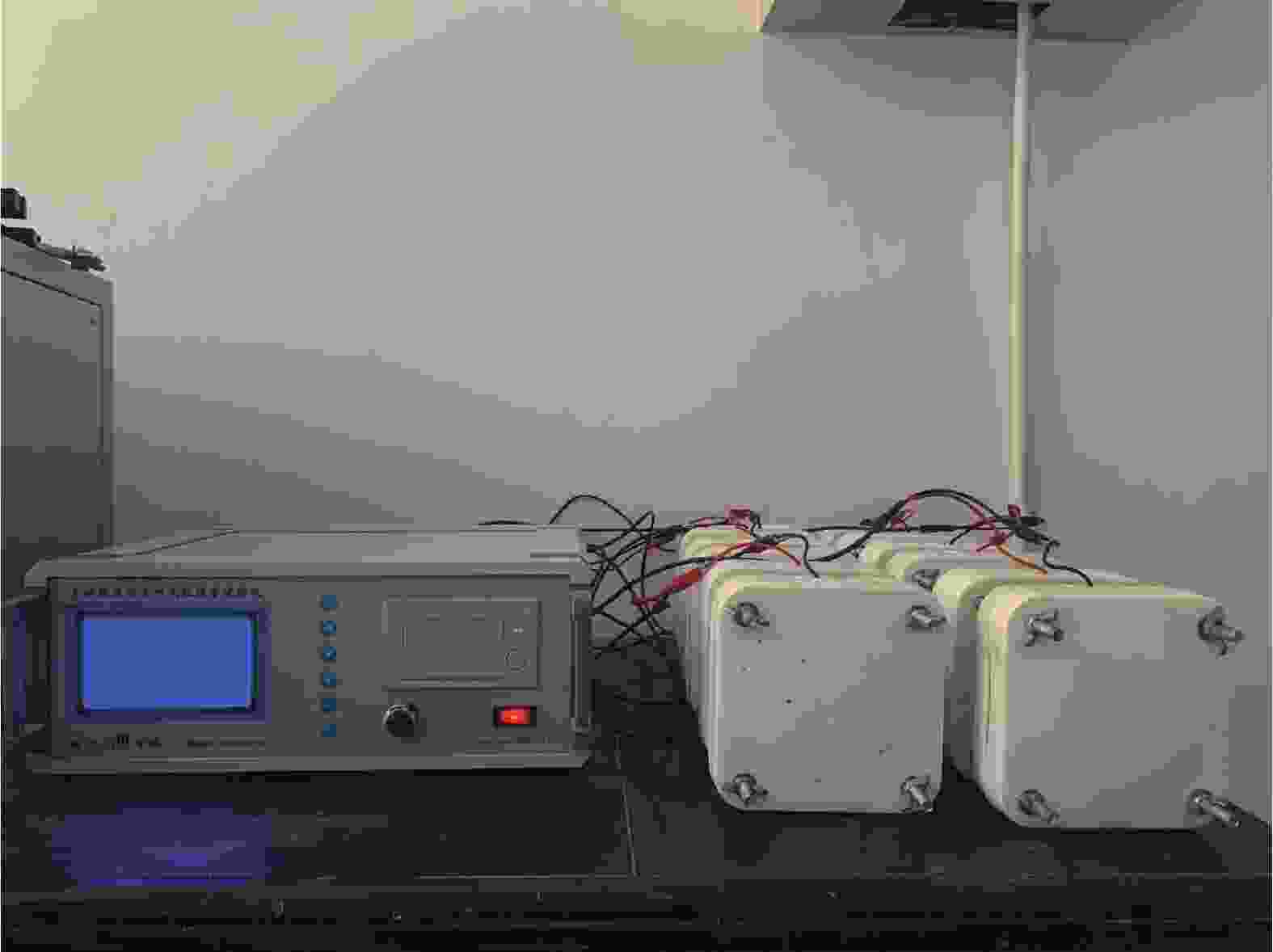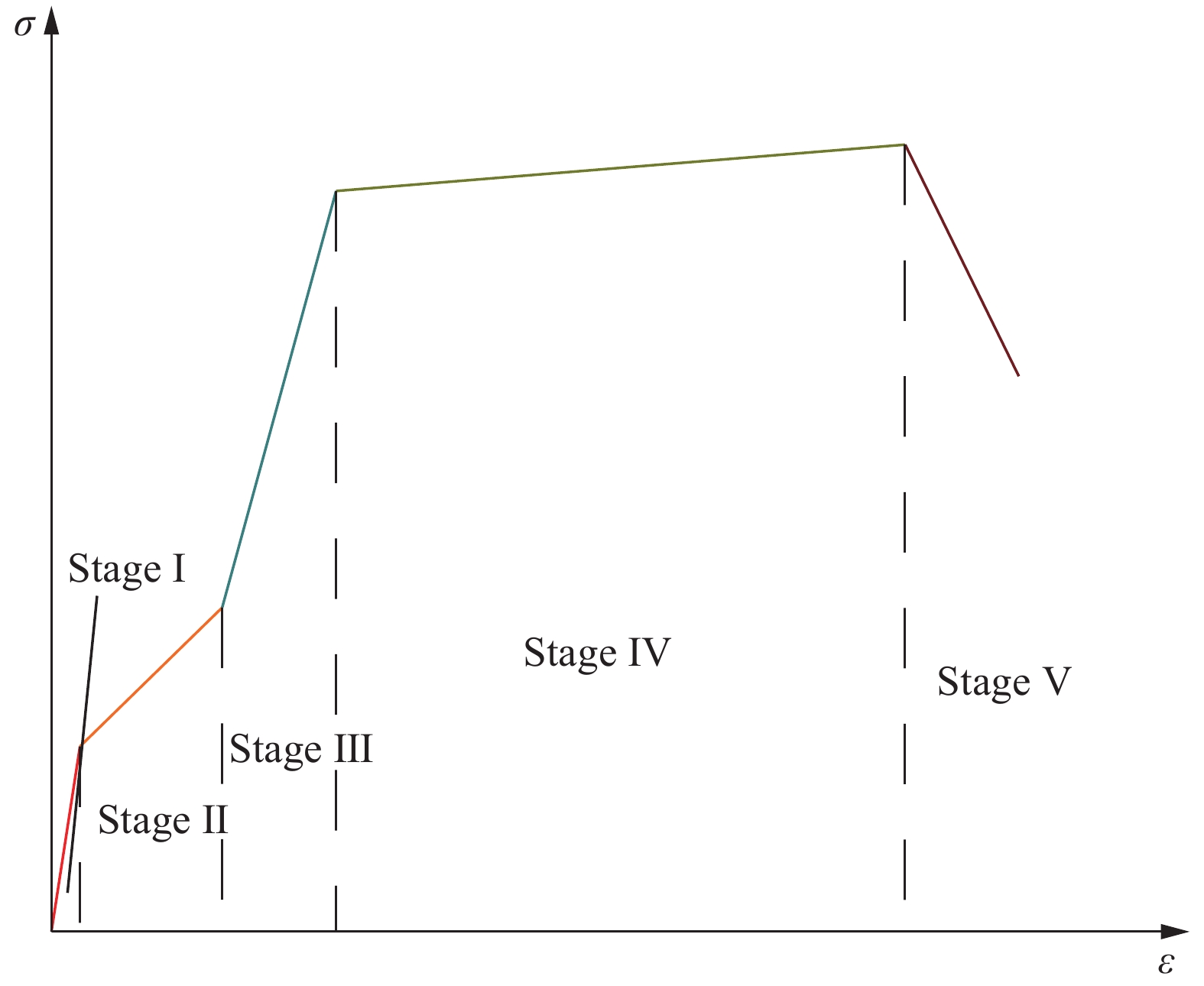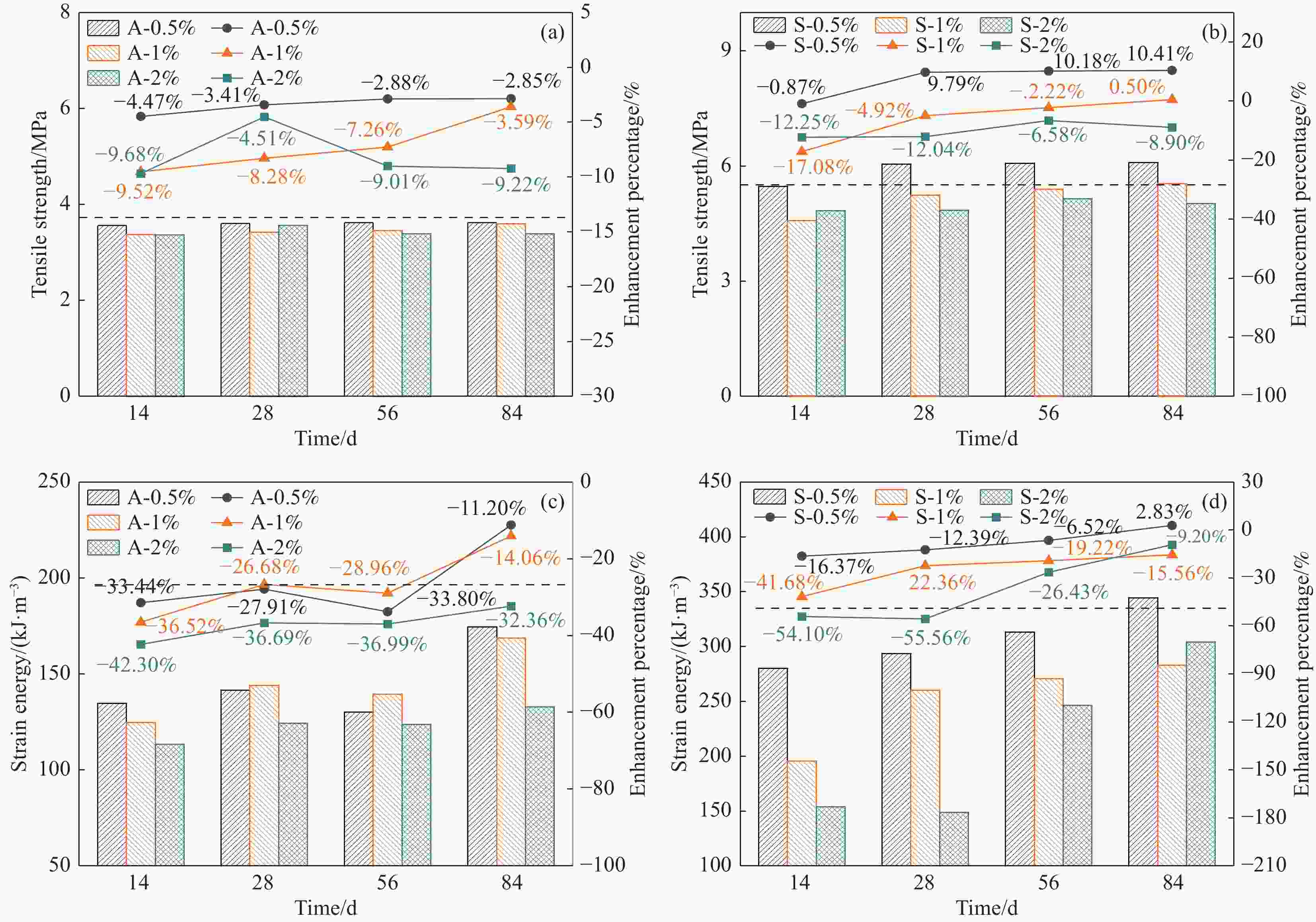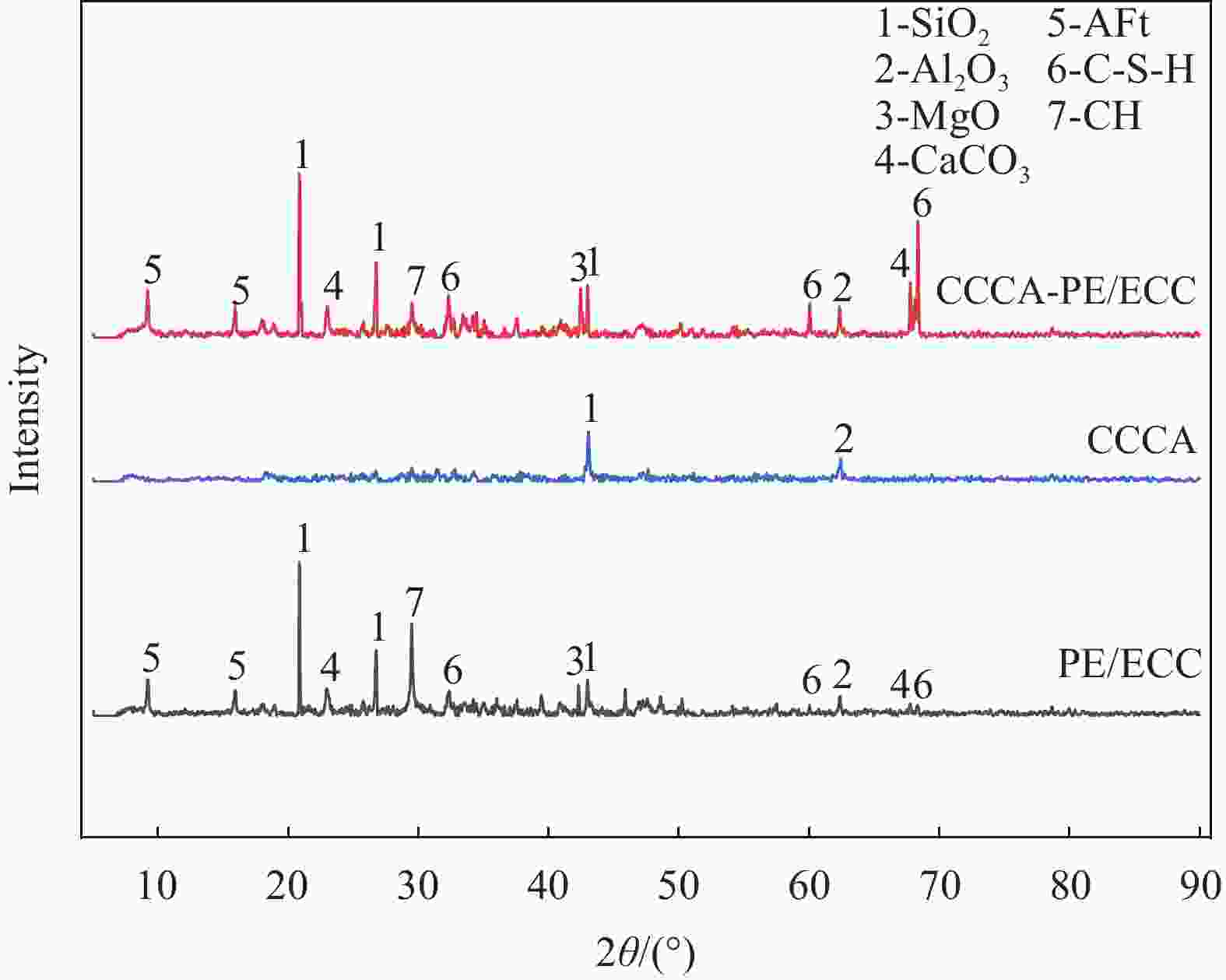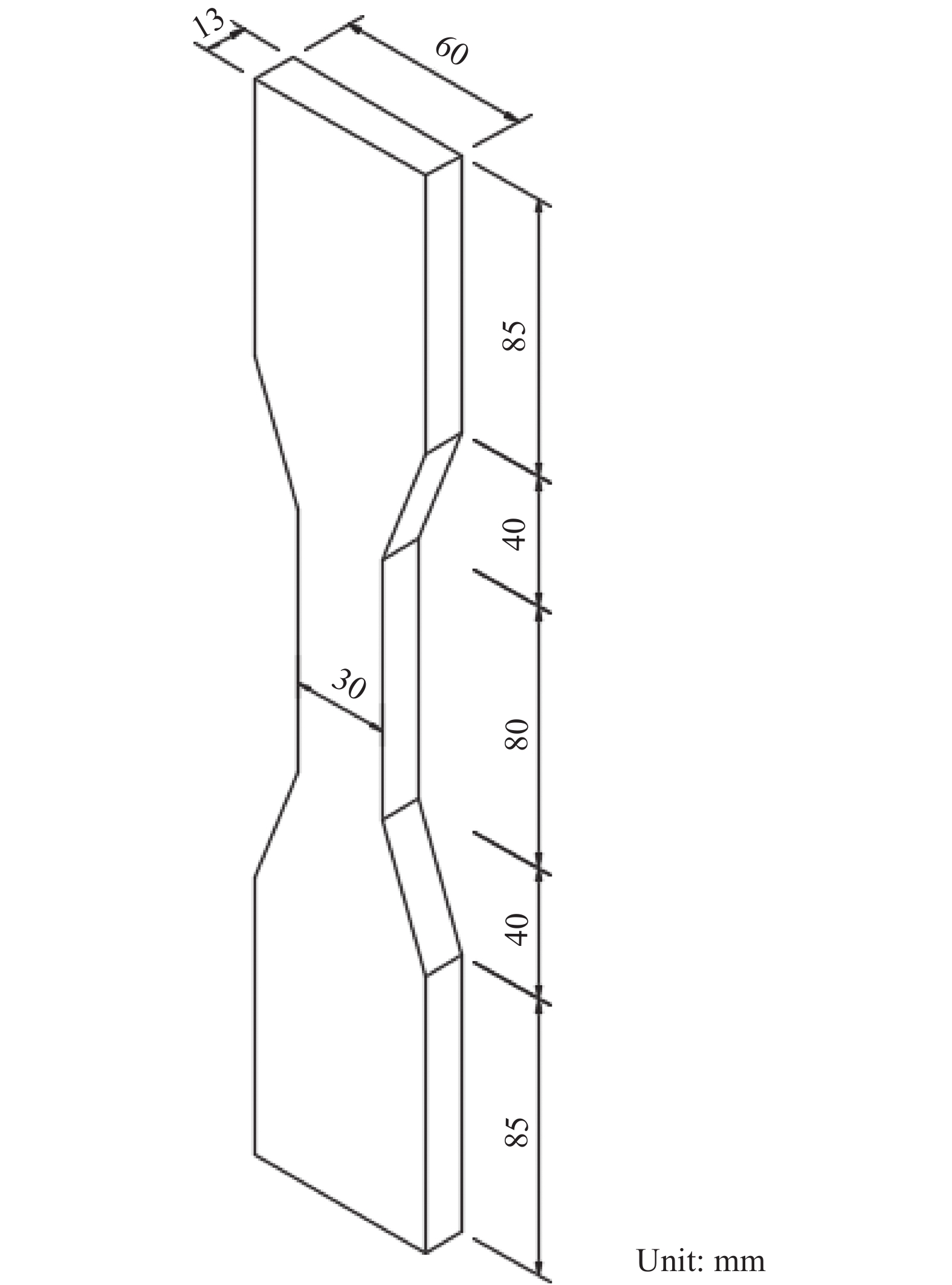Effect of capillary crystalline cement additive on the mechanical, anti-chloride ion permeability, and self-healing properties of PE/ECC
-
摘要: 为研究无机增殖剂(CCCA)对聚乙烯(PE)纤维增强高延性水泥基复合材料(ECC)力学、抗氯离子渗透及自愈合性能的影响,以PE/ECC为对照组,分别掺入不同质量分数的CCCA (2wt%、4wt%、6wt%、8wt%、10wt%),通过抗压、抗折、抗拉、电通量法及预加应变损伤法对PE/ECC力学、抗氯离子渗透及自愈合性能进行研究,并利用XRD、SEM-EDS对其自愈合产物进行物相成分、微观形貌及元素组成分析。结果表明:随着CCCA掺量的增加,PE/ECC力学和抗氯离子渗透性能呈先增后减趋势,当CCCA掺量为4wt%时,CCCA对PE/ECC力学和抗氯离子渗透性能整体提升最为明显,抗压、抗折、极限抗拉强度分别提升了55.5%、10.8%、79.4%,极限拉应变变化不大,电通量下降了38.6%。自愈合试验表明,掺入CCCA后,PE/ECC抗拉强度和应变能的恢复率有明显提升,自愈合性能得到了增强。当预损伤应变为0.5%时,掺CCCA的PE/ECC试件抗拉强度和应变能在养护84天后均高于原始基体,较原始基体分别提高10.41%和2.83%。未掺CCCA的PE/ECC试件在3种应变损伤下的抗拉强度和应变能均低于原始基体。XRD和SEM-EDS结果显示,掺CCCA的PE/ECC水化产物中CaCO3、水化硅酸钙(C-S-H)、钙矾石(AFt)衍射峰值强度有所增长,自愈合产物主要是C-S-H晶体,且掺CCCA的PE/ECC中分布更密集。Abstract: To study the effects of capillary crystalline cement additive (CCCA) on the mechanical, chloride ion penetration resistance and self-healing properties of polyethylene (PE) fiber reinforced engineered cementitious composites (ECC), PE/ECC was used as the control group and mixed with different mass fractions of CCCA (2wt%, 4wt%, 6wt%, 8wt%, 10wt%), and the mechanical, anti-chloride ion permeability and self-healing properties of PE/ECC were investigated by compressive, flexural, tensile, electric flux method and pre-loaded strain damage method, and the self-healing products were analyzed by XRD and SEM-EDS for their physical composition, microscopic morphology and elemental composition. The results show that: The mechanical and anti-chloride ion permeability of PE/ECC increase and then decrease with the increase of CCCA doping, and when the doping of CCCA is 4wt%, the mechanical and anti-chloride ion permeability of PE/ECC is most obviously improved by CCCA, and the compressive strength, flexural strength and ultimate tensile stress increase by 55.5%, 10.8%, and 79.4%, respectively. The ultimate tensile strain does not change much, and the electrical flux decreases by 38.6%. The self-healing test shows that the recovery rate of tensile strength and strain energy of PE/ECC is significantly improved after doping with CCCA, and the self-healing performance is enhanced. When the pre-damage strain is 0.5%, the tensile strength and strain energy of PE/ECC specimens doped with CCCA are higher than those of the original matrix after 84 days of maintenance, which are 10.41% and 2.83% higher than those of the original matrix, respectively. The tensile strength and strain energy of PE/ECC specimens without CCCA are lower than those of undamaged specimens under three strain damages. The XRD and SEM-EDS results show that the CaCO3, calcium silicate hydrate (C-S-H), and ettringite (AFt) intensity diffraction peaks increase in the hydration products of PE/ECC with CCCA, and the self-healing products are mainly C-S-H crystals, and the distribution is denser in the PE/ECC with CCCA.
-
图 8 不同预损伤PE/ECC试件的拉伸应力-应变曲线
Figure 8. Tensile stress-strain curves of the different pre-damage PE/ECC specimens
The labels represent group (A/S)-the pre-loaded strain level-curing time-pre-loaded (Pre)/re-loaded after healing (Re); e.g. A-0.5%-14Re means the specimen in group A with pre-loaded strain of 0.5% is re-loaded after 14 days of self-healing
表 1 聚乙烯(PE)纤维性能指标
Table 1. Polyethylene (PE) fiber performance index
Density/
(g·cm−3)Diameter/
mmLength/
mmElastic modulus/
GPa0.97 0.025 18 116 Note: SJ—Sealant for joints. 表 2 无机增殖剂(CCCA)化学组成
Table 2. Chemical composition of capillary crystalline cement additive (CCCA)
SiO2/wt% Al2O3/wt% Fe2O3/wt% CaO/wt% MgO/wt% HF/wt% NaCl/wt% SJ/wt% Loss/wt% 73.45 12.50 3.5 2.0 1.5 1.8 0.015 3.00 2.235 表 3 PE/高延性水泥基复合材料(ECC) 配合比
Table 3. Mix proportions of PE/engineered cementitious composites (ECC)
Sand/(kg·m−3) Cement/(kg·m−3) Fly ash/(kg·m−3) Water/(kg·m−3) HRWR/(kg·m−3) Fiber/(kg·m−3) CCCA/(kg·m−3) 474.4 593.0 711.6 313.1 4.0 19.0 0.0 474.4 593.0 711.6 313.1 4.0 19.0 26.1 474.4 593.0 711.6 313.1 4.0 19.0 52.2 474.4 593.0 711.6 313.1 4.0 19.0 78.3 474.4 593.0 711.6 313.1 4.0 19.0 104.4 474.4 593.0 711.6 313.1 4.0 19.0 130.5 Note: HRWR—High range water reducer. 表 4 抗拉自愈合试验分组
Table 4. Test grouping of tensile self-healing specimen
Specimen Preloading level Curing time/d S-PL-CT 0.5%/1%/2% 14/28/56/84 A-PL-CT 0.5%/1%/2% 14/28/56/84 Notes: S and A—Experimental group and the control group; PL—Preloading level; CT—Curing time. 表 5 PE/ECC试件拉伸应变云图
Table 5. Strain nephograms of PE/ECC tensile specimens
CCCA content Initial stage of strain hardening Middle stage of strain hardening Strain softening stage 0wt% 


2wt% 


4wt% 


6wt% 


8wt% 


10wt% 


-
[1] ZHANG D, WU H, LI V C, et al. Autogenous healing of engineered cementitious composites (ECC) based on MgO-fly ash binary system activated by carbonation curing[J]. Construction and Building Materials,2020,238:117672. doi: 10.1016/j.conbuildmat.2019.117672 [2] YUNOVICH M, THOMPSON N G. Corrosion of highway bridges: Economic impact and control methodologies[J]. Concrete International,2003,25(1):52-57. [3] BETTIGOLE N H. Rebuilding our bridges-why and how[J]. ASTM Standardization News,1994,22:24-27. [4] LI V C, MISHRA D K, WU H C. Matrix design for pseudo-strain-hardening fibre reinforced cementitious compo-sites[J]. Materials and Structures,1995,28(10):586-595. doi: 10.1007/BF02473191 [5] LI V C, LEUNG C K Y. Steady-state and multiple cracking of short random fiber composites[J]. Journal of Engineering Mechanics,1992,118(11):2246-2264. doi: 10.1061/(ASCE)0733-9399(1992)118:11(2246) [6] LI V C, STANG H, KRENCHEL H. Micromechanics of crack bridging in fiber-reinforced concrete[J]. Materials and Structures,1993,26(8):486-494. doi: 10.1007/BF02472808 [7] ZHANG Z, QIAN S, MA H, et al. Investigating mechanical properties and self-healing behavior of micro-cracked ECC with different volume of fly ash[J]. Construction and Building Materials,2014,52(1):17-23. [8] YANG Y, LEPECH M D, YANG E H, et al. Autogenous healing of engineered cementitious composites under wet-dry cycles[J]. Cement and Concrete Research,2009,39(5):382-390. doi: 10.1016/j.cemconres.2009.01.013 [9] LI V C. On engineered cementitious composites (ECC) a review of the material and its applications[J]. Journal of Advanced Concrete Technology,2003,1(3):215-230. doi: 10.3151/jact.1.215 [10] ZHANG C, LU R, LI Y, et al. Effect of crystalline admixtures on mechanical, self-healing and transport properties of engineered cementitious composite[J]. Cement and Concrete Composites,2021,124:104256. doi: 10.1016/j.cemconcomp.2021.104256 [11] SAHMARAN M, YILDIRIM G, ERDEM T K. Self-healing capability of cementitious composites incorporating different supplementary cementitious materials[J]. Cement and Concrete Composites, 2013, 35(1): 89-101. [12] 荣耀. 海底隧道衬砌裂缝控制关键技术研究[D]. 上海: 同济大学, 2007.RONG Yao. The research on the key technology of the crack controlling of reinforced concrete lining of undersea tunnel[D]. Shanghai: Tongji University, 2007(in Chinese). [13] WU B, OU Y. Experimental study on tunnel lining joints temporarily strengthened by SMA bolts[J]. Smart Materials and Structures,2014,23(12):125018. doi: 10.1088/0964-1726/23/12/125018 [14] DRY C. Matrix cracking repair and filling using active and passive modes for smart timed release of chemicals from fibers into cement matrices[J]. Smart Materials and Structures,1994,3(2):118-123. doi: 10.1088/0964-1726/3/2/006 [15] DRY C. Procedures developed for self-repair of polymer matrix composite materials[J]. Composite Structures,1996,35(3):263-269. doi: 10.1016/0263-8223(96)00033-5 [16] DRY C, MCMILLAN W. Three-part methylmethacrylate adhesive system as an internal delivery system for smart responsive concrete[J]. Smart Materials and Structures,1996,5(3):297-300. doi: 10.1088/0964-1726/5/3/007 [17] DONG B, FANG G, WANG Y, et al. Performance recovery concerning the permeability of concrete by means of a microcapsule based self-healing system[J]. Cement and Concrete Composites,2017,78:84-96. doi: 10.1016/j.cemconcomp.2016.12.005 [18] WHITE S R, SOTTOS N R, GEUBELLE P H, et al. Autonomic healing of polymer composites[J]. Nature,2001,409:794-797. doi: 10.1038/35057232 [19] BOH B, SUMIGA B. Microencapsulation technology and its applications in building construction materials[J]. RMZ-Materials and Geoenvironment,2008,55:329-344. [20] JIANG J, LI J, LI W. Preparation and characterization of autolytic mineral microsphere for self-healing cementitious materials[J]. Cement and Concrete Composites,2019,103:112-120. doi: 10.1016/j.cemconcomp.2019.04.004 [21] IONKERS H M, THIJSSEN A, MUYZER G, et al. Application of bacteria as self-healing agent for the development of sustainable concrete[J]. Ecological Engineering,2010,36(2):230-235. doi: 10.1016/j.ecoleng.2008.12.036 [22] DICK J, WINDT W D, GRAEF B D, et al. Bio-deposition of a calcium carbonate layer on degraded limestone by Bacillus species[J]. Biodegradation,2006,17(4):357-367. doi: 10.1007/s10532-005-9006-x [23] XU J, YAO W. Multiscale mechanical quantification of self-healing concrete incorporating non-ureolytic bacteria-based healing agent[J]. Cement and Concrete Research,2014,64:1-10. doi: 10.1016/j.cemconres.2014.06.003 [24] LING H, QIAN C. Effects of self-healing cracks in bacterial concrete on the transmission of chloride during electromigration[J]. Construction and Building Materials,2017,144:406-411. doi: 10.1016/j.conbuildmat.2017.02.160 [25] TERMKHAJORNKIT P, NAWA T, YAMASHIRO Y, et al. Self-healing ability of fly ash-cement systems[J]. Cement and Concrete Composites,2009,31(3):195-203. doi: 10.1016/j.cemconcomp.2008.12.009 [26] NA S H, HAMA Y, TANIGUCHI M, et al. Experimental investigation on reaction rate and self-healing ability in fly ash blended cement mixtures[J]. Journal of Advanced Concrete Technology,2012,10(7):240-253. doi: 10.3151/jact.10.240 [27] SISOMPHON K, COPUROGLU O, KOENDERS E A B. Self-healing of surface cracks in mortars with expansive additive and crystalline additive[J]. Cement and Concrete Composites,2012,34(4):566-574. doi: 10.1016/j.cemconcomp.2012.01.005 [28] HUANG H, YE G. Simulation of self-healing by further hydration in cementitious materials[J]. Cement and Concrete Composites,2012,34(4):460-467. doi: 10.1016/j.cemconcomp.2012.01.003 [29] TITTELBOOM V K, BELIE N D. Self-healing in cementitious materials—A review[J]. Materials,2013,6(6):2182-2217. doi: 10.3390/ma6062182 [30] LI V C, HERBERT E. Robust self-healing concrete for sustainable infrastructure[J]. Journal of Advanced Concrete Technology,2012,10(6):207-218. doi: 10.3151/jact.10.207 [31] OZBAY E, SAHMARAN M, LACHEMI M, et al. Self-healing of microcracks in high-volume fly-ash-incorporated engi-neered cementitious composites[J]. ACI Materials Journal,2013,110(1):33-43. [32] HUNG C C, SU Y F, HUNG H H. Impact of natural weathering on medium-term self-healing performance of fiber reinforced cementitious composites with intrinsic crack-width control capability[J]. Cement and Concrete Composites,2017,80:200-209. doi: 10.1016/j.cemconcomp.2017.03.018 [33] 中华人民共和国住房和城乡建设部. 混凝土物理力学性能试验方法标准: GB/T 50081—2019[S]. 北京: 中国建筑工业出版社, 2019.Ministry of Housing and Urban-Rural Development of the People's Republic of China. Standard for test methods of concrete physical and mechanical properties: GB/T 50081—2019[S]. Beijing: China Architecture & Building Press, 2019(in Chinese). [34] 中华人民共和国住房和城乡建设部. 普通混凝土长期性能和耐久性能试验方法标准: GB/T 50082—2009[S]. 北京: 中国建筑工业出版社, 2019.Ministry of Housing and Urban-Rural Development of the People's Republic of China. Standard for test methods of long-term performance and durability of ordinary concrete: GB/T 50082—2009[S]. Beijing: China Architecture & Building Press, 2009(in Chinese). [35] NIU Y, WEI J, JIAO C. Crack propagation behavior of ultra-high-performance concrete (UHPC) reinforced with hybrid steel fibers under flexural loading[J]. Construction and Building Materials,2021,294:123510. doi: 10.1016/j.conbuildmat.2021.123510 [36] KAN L, WANG F, ZHANG Z, et al. Mechanical properties of high ductile alkali-activated fiber reinforced composites with different curing ages[J]. Construction and Building Materials,2021,306:124833. doi: 10.1016/j.conbuildmat.2021.124833 [37] JIANG J, ZHENG X, WU S, et al. Nondestructive experimental characterization and numerical simulation on self-healing and chloride ion transport in cracked ultra-high performance concrete[J]. Construction and Building Materials,2019,198:696-709. doi: 10.1016/j.conbuildmat.2018.11.054 -






 下载:
下载:

